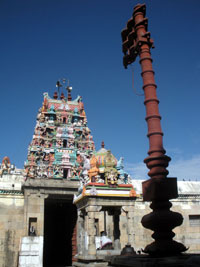
The Srikalahasti Temple is located in the town of Srikalahasti, in Tirupati district in the state of Andhra Pradesh, India. According to regional tradition, it is said to be the site where Kannappa was ready to offer both his eyes to cover blood flowing from the Shivalinga before Shiva stopped him and granted him moksha. The inner temple was constructed around the 5th century CE and the outer temple was constructed in the 11th century by the Rajendra Chola I and other Chola emperors such as Rajaditya Chola, Rajaraja Chola I, Rajadhiraja Chola I, Kulottunga Chola I, Kulottunga Chola III, and Reddi kingdom,Vijayanagar Empire. The 120 feet (37 m) high main gopuram and the hundred pillared hall with intricate carvings was commissioned during the regime of the Vijayanagara Krishnadevaraya during 1516 CE. Shiva in his aspect as Vayu is worshipped as Kalahasteeswara. The temple is also regarded as Rahu-Ketu kshetra and Dakshina Kailasam.

Tiruppukkozhiyur is a Hindu temple dedicated to the deity Shiva, located in Avinasi, a panchayat town in Tiruppur district in the South Indian state of Tamil Nadu. Shiva is worshipped as Avinasiappar, and is represented by the lingam. His consort Parvati is depicted as Karunambigai. The presiding deity is revered in the 7th century Tamil Saiva canonical work, the Tevaram, written by Tamil saint poets known as the Nayanars and classified as Paadal Petra Sthalam.
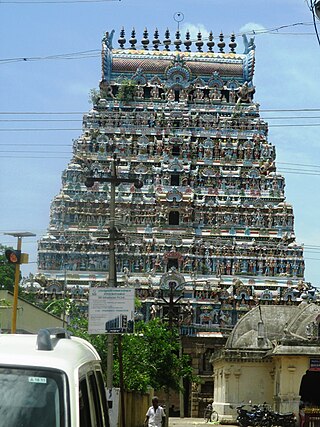
Mahalingeswaraswamy Temple, Thiruvidaimarudur is a Hindu temple dedicated to the deity Shiva, located in Tiruvidaimaruthur, a village in the South Indian state of Tamil Nadu. It is significant to the Hindu sect of Saivism as one of the seven major Shiva temples. Shiva is worshiped as Mahalingeswaraswamy, and is represented by the lingam, with his idol referred to as Jyothirmayalingam. His consort Mookambika is depicted as Devi Bruhatsundarakuchaambika or Bruhatsundarakuchaambigai amman. The lingam of the temple is believed to be the focal point for the seven consorts of Shiva. The presiding deity is revered in the 7th century Tamil Saiva canonical work, the Tevaram, written by Tamil poet saints known as the nayanars and classified as Paadal Petra Sthalam. The 9th century Saiva saint poet Manikkavacakar has sung praise about the temple in his works. Pattinattar, one of the revered saints visited this shrine many times.
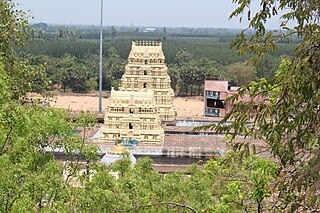
Devanatha Hemabhujavalli Temple (Thiruvaheendrapuram) is a Hindu temple in Thiruvanthipuram, a village in the outskirts of Cuddalore in the South Indian state of Tamil Nadu, dedicated to the god Vishnu and goddess Lakshmi. Constructed in the Dravidian style of architecture, the temple is glorified in the Nalayira Divya Prabandham, the early medieval Tamil canon of the Alvar saints from the 6th–9th centuries CE. It is one of the 108 Divya Desams dedicated to Vishnu, who is worshipped as Devanatha and Lakshmi as Hemabhujavalli. Though the presiding deity is Devanatha and Hemabhujavalli, the temple is known for Hayagriva, the ninth avatara of Vishnu in the Dashavatara of Vishnu and a god of knowledge. The temple is the only historical temple in South India to have a shrine of Hayagriva on hilltop.

Kandeeswarar Temple is a Hindu temple dedicated to the god Shiva located in Kandiyur also known as Thirukkandiyur or Tirukkandiyur, near Tiruvaiyaru, Tamil Nadu, India. Shiva is worshiped as Kandeeswarar, and is represented by the lingam and his consort Parvati is depicted as Mangalanayagi. The presiding deity is revered in the 7th century Tamil Saiva canonical work, the Tevaram, written by Tamil poet saints known as the nayanars and classified as Paadal Petra Sthalam. As per legends, Shiva is believed to have destroyed eight different demons and the eight Ashta Veeratanam temples are built signifying each of his victories in the war. The temple is one of the eight where Shiva is believed to have removed one of the five heads of Brahma.

Tirupavalavannam or Pavalavanam temple located in Kanchipuram in the South Indian state of Tamil Nadu, is dedicated to the Hindu god Vishnu. Constructed in the Dravidian style of architecture, the temple is glorified in the Nalayira Divya Prabandham, the early medieval Tamil canon of the Alvar saints from the 6th–9th centuries CE. It is one of the 108 Divya Desams dedicated to Vishnu, who is worshipped as Pavalavannar Perumal and his consort Lakshmi as Pavalavalli.

Vedaranyeswarar Temple is a Hindu temple dedicated to the god Shiva, located in the town of Vedaranyam in Tamil Nadu, India. Vedaranyeswarar is revered in the 7th-century-CE Tamil Shaiva canonical work, the Tevaram, written by Tamil saint poets known as the Nayanars and classified as Paadal Petra Sthalam. It is the only temple to have found mention in all the seven Thirumurais. The temple is famed for the legend between the saints Appar and Sambandar when the former sang to open the door while the latter sang to close the door.
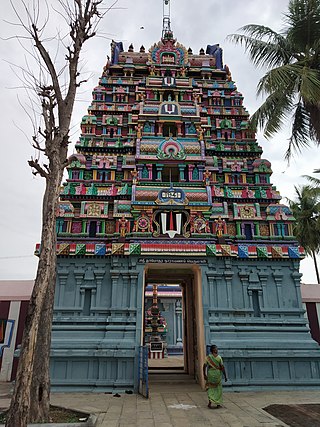
The Loganatha Perumal Temple is a Hindu temple dedicated to Vishnu located 2 km away from Sikkal, Tamil Nadu, India on the Tiruvarur-Nagapatnam highway. Constructed in the Dravidian style of architecture, the temple is glorified in the Nalayira Divya Prabandham, the early medieval Tamil canon of the Alvar saints from the 6th–9th centuries CE. It is one of the 108 Divya Desams dedicated to Vishnu, who is worshiped as Loganatha Perumal and his consort Lakshmi as Loganayagi.

Nadutariappar Temple, Kanrappur is a Hindu temple dedicated to Shiva located at Kanrappur near Tiruvarur, Tamil Nadu, India. The temple is incarnated by the hymns of Appar and is classified as Paadal Petra Sthalam.

Dharbaranyeswarar Temple, more popularly known as Tirunallar Saniswaran Temple, is a Hindu temple dedicated to the deity Shiva, located in the Thirunallar village of the Karaikal district, in the Union territory of Puducherry, Southeastern India.
Brahmapureeswarar Temple or Thirukolili is a Hindu temple dedicated to Shiva located in Thirukkuvalai in Nagapattinam district of Tamil Nadu, India. Shiva is worshiped as Brahmapureeswarar, and is represented by the lingam and his consort Parvati is depicted as Vandamar Poonguzhali. The presiding deity is revered in the 7th-century-CE Tamil Saiva canonical work, the Tevaram, written by Tamil poet saints known as the nayanars and classified as Paadal Petra Sthalam.

ThirumarperuManikandeswarar Temple is a Hindu temple dedicated to Shiva in Tirumalpur in Ocheri-Tirumalpur road, Tamil Nadu, India. Constructed in the Dravidian style of architecture, the temple is believed to have been built during the Cholas period in the 9th century. Shiva is worshipped as Manikandeswarar and his consort Parvathi as Karunai Nayagi.

Koneswarar Temple(Tamil: குடவாசல் கோணேசுவரர் கோயில்) is a Hindu temple in the town of Kudavasal in the Tiruvarur district of Tamil Nadu, India. The presiding deity is Shiva.

Ambal Brahmapureeswarar Temple(அம்பல் பிரமபுரீசுவரர் கோயில்) is a Hindu temple located at Ambal in Tiruvarur district, Tamil Nadu, India. Now the place is known as Koilpatthu. The presiding deity is Shiva. He is called as Brahmapureeswarar. His consort is known as Poonkuzhalammai. The historical name of the place is Punnakavanam. Shiva is worshipped as Brahmapureeswarar and his consort Parvathi as Poonguzhalammai. Ampal Brahmapureeswarar is revered in the 7th century Tamil Saiva canonical work, the Tevaram, written by Tamil saint poets known as the Nayanmars and classified as Paadal Petra Sthalam, the 275 temples revered in the canon. The temple is believed to be the last among the sixty maadakoil built by Kochengat Chola.

Othandeeswarar Temple in Thirumazhisai Chennai City in Tiruvallur district in the South Indian state of Tamil Nadu, is dedicated to the Hindu god Shiva. It is located 22 km from the state capital Chennai. Constructed in the Dravidian style of architecture, the temple was built during the 11th century by Chola king Kulothunga Chola II. Shiva is worshipped as Othandeeswarar and his consort Parvathi as Kulirvithanayaki.

Kachabeswarar Temple, Thirukachur is a Hindu temple dedicated to the deity Shiva, located in Thirukachur, a village in Kanchipuram district in the South Indian state of Tamil Nadu. Shiva is worshipped as Kachabeswarar, and is represented by the lingam. His consort Parvati is depicted as Antanatchi and Kanniyumaiyal. The presiding deity is revered in the 7th-century CE Tamil Saiva canonical work, the Tevaram, written by Tamil saint poets known as the Nayanars and classified as Paadal Petra Sthalam. The temple is counted as a twin temple along with Marundeeswarar Temple located in the same village.

Agnipureeswarar Temple in Thirupugalur, a village in Nagapattinam district in the South Indian state of Tamil Nadu, is dedicated to the Hindu god Shiva. Constructed in the Tamil style of architecture, the temple is believed to have been built during the Cholas period in the 10th century. Shiva is worshipped as Agnipureeswarar and his consort Parvathi as Karundar Kuzhali. The temple is believed to be the place where Saiva saint Appar is believed to have attained salvation.

Pushpavaneswarar temple in Thirupuvanam, a town in Sivaganga district in the South Indian state of Tamil Nadu, is dedicated to the Hindu god Shiva. Constructed in the Dravidian style of architecture, the temple is believed to have been built during the Cholas period in the 7th century. Shiva is worshipped as Pushpavaneswarar and his consort Parvathi as Soundaranayagi.
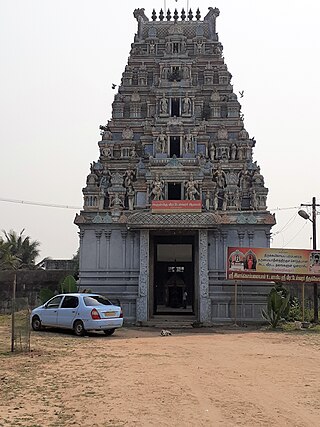
Veerateswarar Temple is a Hindu temple located at Keelaparasalur in Mayiladuthurai district of Tamil Nadu, India. The historical name of the place is Tirupparialur. The presiding deity is Shiva in the form of Veerateswarar and his consort is known as Ilam Kobanayal. The presiding deity is revered in the 7th century Tamil Saiva canonical work, the Tevaram, written by Tamil saint poets known as the nayanars and classified as Paadal Petra Sthalam, the 276 temples that find mention in it.

Thirumeninathar temple is a Hindu temple dedicated to the deity Shiva, located in Tiruchuli in Virudhunagar district, in the South Indian state of Tamil Nadu. Shiva is worshipped as Thirumeninathar, and is represented by the lingam. His consort Parvati is depicted as Thunaimalaiyammai Amman. The temple is located on the Virudhunagar–Manamadurai road. The presiding deity is revered in the 7th-century-CE Tamil Saiva canonical work, the Tevaram, written by Tamil saint poets known as the nayanmars and classified as Paadal Petra Sthalam. The temple is closely associated with Sundarar, who has sung praises about the presiding deity. This shrine is regarded as the 12th of the Tevara Stalams in the Pandya region of Tamil Nadu.
